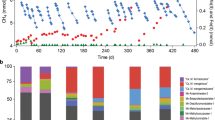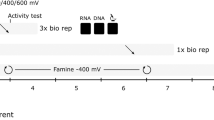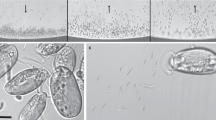Abstract
The anaerobic oxidation of methane (AOM) with sulfate controls the emission of the greenhouse gas methane from the ocean floor1,2. In marine sediments, AOM is performed by dual-species consortia of anaerobic methanotrophic archaea (ANME) and sulfate-reducing bacteria (SRB) inhabiting the methane–sulfate transition zone3,4,5. The biochemical pathways and biological adaptations enabling this globally relevant process are not fully understood. Here we study the syntrophic interaction in thermophilic AOM (TAOM) between ANME-1 archaea and their consortium partner SRB HotSeep-1 (ref. 6) at 60 °C to test the hypothesis of a direct interspecies exchange of electrons7,8. The activity of TAOM consortia was compared to the first ANME-free culture of an AOM partner bacterium that grows using hydrogen as the sole electron donor. The thermophilic ANME-1 do not produce sufficient hydrogen to sustain the observed growth of the HotSeep-1 partner. Enhancing the growth of the HotSeep-1 partner by hydrogen addition represses methane oxidation and the metabolic activity of ANME-1. Further supporting the hypothesis of direct electron transfer between the partners, we observe that under TAOM conditions, both ANME and the HotSeep-1 bacteria overexpress genes for extracellular cytochrome production and form cell-to-cell connections that resemble the nanowire structures responsible for interspecies electron transfer between syntrophic consortia of Geobacter9,10. HotSeep-1 highly expresses genes for pili production only during consortial growth using methane, and the nanowire-like structures are absent in HotSeep-1 cells isolated with hydrogen. These observations suggest that direct electron transfer is a principal mechanism in TAOM, which may also explain the enigmatic functioning and specificity of other methanotrophic ANME–SRB consortia.
This is a preview of subscription content, access via your institution
Access options
Subscribe to this journal
Receive 51 print issues and online access
$199.00 per year
only $3.90 per issue
Buy this article
- Purchase on Springer Link
- Instant access to full article PDF
Prices may be subject to local taxes which are calculated during checkout



Similar content being viewed by others
Accession codes
Primary accessions
BioProject
GenBank/EMBL/DDBJ
Data deposits
Representative full-length 16S rRNA gene sequences of TAOM and HotSeep-1 enrichment have been submitted to NCBI GenBank under accession numbers KT152859–KT152885 and KT759143–KT759147, functional genes under the accession numbers KT152886, KT152887 and KT795302–KT795321, and genomic 16S rRNA genes under the accession numbers KT795322 and KT795323. Sequencing projects are registered at NCBI under the BioProject accession numbers PRJNA286178 (TAOM enrichment) and PRJNA276404 (HotSeep-1 enrichment).
References
Reeburgh, W. S. Oceanic methane biogeochemistry. Chem. Rev. 107, 486–513 (2007)
Boetius, A. & Wenzhöfer, F. Seafloor oxygen consumption fuelled by methane from cold seeps. Nat. Geosci. 6, 725–734 (2013)
Hinrichs, K.-U., Hayes, J. M., Sylva, S. P., Brewer, P. G. & DeLong, E. F. Methane-consuming archaebacteria in marine sediments. Nature 398, 802–805 (1999)
Boetius, A. et al. A marine microbial consortium apparently mediating anaerobic oxidation of methane. Nature 407, 623–626 (2000)
Orphan, V. J. et al. Comparative analysis of methane-oxidizing archaea and sulfate-reducing bacteria in anoxic marine sediments. Appl. Environ. Microbiol. 67, 1922–1934 (2001)
Holler, T. et al. Thermophilic anaerobic oxidation of methane by marine microbial consortia. ISME J. 5, 1946–1956 (2011)
Thauer, R. K. & Shima, S. Methane as fuel for anaerobic microorganisms. Ann. NY Acad. Sci. 1125, 158–170 (2008)
McGlynn, S. E., Chadwick, G. L., Kempes, C. P. & Orphan, V. J. Single cell activity reveals direct electron transfer in methanotrophic consortia. Nature http://dx.doi.org/10.1038/nature15512 (this issue)
Reguera, G. et al. Extracellular electron transfer via microbial nanowires. Nature 435, 1098–1101 (2005)
Summers, Z. M. et al. Direct exchange of electrons within aggregates of an evolved syntrophic coculture of anaerobic bacteria. Science 330, 1413–1415 (2010)
Knittel, K. & Boetius, A. Anaerobic oxidation of methane: progress with an unknown process. Annu. Rev. Microbiol. 63, 311–334 (2009)
Niemann, H. et al. Novel microbial communities of the Haakon Mosby mud volcano and their role as a methane sink. Nature 443, 854–858 (2006)
Schreiber, L., Holler, T., Knittel, K., Meyerdierks, A. & Amann, R. Identification of the dominant sulfate-reducing bacterial partner of anaerobic methanotrophs of the ANME-2 clade. Environ. Microbiol. 12, 2327–2340 (2010)
Hoehler, T. M., Alperin, M. J., Albert, D. B. & Martens, C. S. Field and laboratory studies of methane oxidation in an anoxic marine sediment: evidence for a methanogen-sulfate reducer consortium. Glob. Biogeochem. Cycles 8, 451–463 (1994)
Krüger, M. et al. A conspicuous nickel protein in microbial mats that oxidize methane anaerobically. Nature 426, 878–881 (2003)
Hallam, S. J. et al. Reverse methanogenesis: testing the hypothesis with environmental genomics. Science 305, 1457–1462 (2004)
Meyerdierks, A. et al. Metagenome and mRNA expression analyses of anaerobic methanotrophic archaea of the ANME-1 group. Environ. Microbiol. 12, 422–439 (2010)
Kojima, H., Moll, J., Kahnt, J., Fukui, M. & Shima, S. A reversed genetic approach reveals the coenzyme specificity and other catalytic properties of three enzymes putatively involved in anaerobic oxidation of methane with sulfate. Environ. Microbiol. 16, 3431–3442 (2014)
Thauer, R. K. Anaerobic oxidation of methane with sulfate: on the reversibility of the reactions that are catalyzed by enzymes also involved in methanogenesis from CO2 . Curr. Opin. Microbiol. 14, 292–299 (2011)
Milucka, J., Widdel, F. & Shima, S. Immunological detection of enzymes for sulfate reduction in anaerobic methane-oxidizing consortia. Environ. Microbiol. 15, 1561–1571 (2013)
Milucka, J. et al. Zero-valent sulphur is a key intermediate in marine methane oxidation. Nature 491, 541–546 (2012)
Schink, B. Energetics of syntrophic cooperation in methanogenic degradation. Microbiol. Mol. Biol. Rev. 61, 262–280 (1997)
Stams, A. J. & Plugge, C. M. Electron transfer in syntrophic communities of anaerobic bacteria and archaea. Nature Rev. Microbiol. 7, 568–577 (2009)
Moran, J. J. et al. Methyl sulfides as intermediates in the anaerobic oxidation of methane. Environ. Microbiol. 10, 162–173 (2008)
Stokke, R., Roalkvam, I., Lanzen, A., Haflidason, H. & Steen, I. H. Integrated metagenomic and metaproteomic analyses of an ANME‐1‐dominated community in marine cold seep sediments. Environ. Microbiol. 14, 1333–1346 (2012)
Nagarajan, H. et al. Characterization and modelling of interspecies electron transfer mechanisms and microbial community dynamics of a syntrophic association. Nature Commun. 4, 2809 (2013)
Rotaru, A.-E. et al. A new model for electron flow during anaerobic digestion: direct interspecies electron transfer to Methanosaeta for the reduction of carbon dioxide to methane. Energ. Environ. Sci. 7, 408–415 (2014)
Malvankar, N. S. et al. Structural basis for metallic-like conductivity in microbial nanowires. MBio 6, e00084–e00015 (2015)
Methé, B. A. et al. Genome of Geobacter sulfurreducens: metal reduction in subsurface environments. Science 302, 1967–1969 (2003)
Reitner, J. et al. Concretionary methane-seep carbonates and associated microbial communities in Black Sea sediments. Palaeogeogr. Palaeoclimatol. Palaeoecol. 227, 18–30 (2005)
Widdel, F. & Bak, F. in The Prokaryotes Vol. 4 (eds Trüper, H. G., Balows, A., Dworkin, M., Harder, W. & Schleifer, K. H. ) 3352–3378 (Springer, 1992)
Zhou, J., Bruns, M. A. & Tiedje, J. M. DNA recovery from soils of diverse composition. Appl. Environ. Microbiol. 62, 316–322 (1996)
Muyzer, G., Teske, A., Wirsen, C. O. & Jannasch, H. W. Phylogenetic relationships of Thiomicrospira species and their identification in deep-sea hydrothermal vent samples by denaturing gradient gel electrophoresis of 16S rDNA fragments. Arch. Microbiol. 164, 165–172 (1995)
Massana, R., Murray, A., Preston, C. & DeLong, E. Vertical distribution and phylogenetic characterization of marine planktonic Archaea in the Santa Barbara Channel. Appl. Environ. Microbiol. 63, 50–56 (1997)
Teske, A. et al. Microbial diversity of hydrothermal sediments in the Guaymas Basin: evidence for anaerobic methanotrophic communities. Appl. Environ. Microbiol. 68, 1994–2007 (2002)
Ludwig, W. et al. ARB: a software environment for sequence data. Nucleic Acids Res. 32, 1363–1371 (2004)
Pruesse, E. et al. SILVA: a comprehensive online resource for quality checked and aligned ribosomal RNA sequence data compatible with ARB. Nucleic Acids Res. 35, 7188–7196 (2007)
Pernthaler, A., Pernthaler, J. & Amann, R. Fluorescence in situ hybridization and catalyzed reporter deposition for the identification of marine bacteria. Appl. Environ. Microbiol. 68, 3094–3101 (2002)
Steudel, R., Göbel, T. & Holdt, G. The molecular composition of hydrophilic sulfur sols prepared by decomposition of thiosulfate. Z. Naturforsch. B Chem. Sci. 43, 203–218 (1988)
Cord-Ruwisch, R. A quick method for the determination of dissolved and precipitated sulfides in cultures of sulfate-reducing bacteria. Microbiol. Meth. 4, 33–36 (1985)
Bankevich, A. et al. SPAdes: a new genome assembly algorithm and its applications to single-cell sequencing. J. Comput. Biol. 19, 455–477 (2012)
Strous, M., Kraft, B., Bisdorf, R. & Tegetmeyer, H. E. The binning of metagenomic contigs for microbial physiology of mixed cultures. Front. Microbiol. 3, 410 (2012)
Seemann, T. Prokka: rapid prokaryotic genome annotation. Bioinformatics 30, 2068–2069 (2014)
Meyer, F. et al. GenDB—an open source genome annotation system for prokaryote genomes. Nucleic Acids Res. 31, 2187–2195 (2003)
Richter, M. et al. JCoast — a biologist-centric software tool for data mining and comparison of prokaryotic (meta) genomes. BMC Bioinformatics 9, 177 (2008)
Richter, M. & Rosselló-Móra, R. Shifting the genomic gold standard for the prokaryotic species definition. Proc. Natl Acad. Sci. USA 106, 19126–19131 (2009)
Eddy, S. HMMER User’s Guide. Biological sequence analysis using profile hidden Markov models (Howard Hughes Medical Institute, 2003)
Finn, R. D., Miller, B. L., Clements, J. & Bateman, A. iPfam: a database of protein family and domain interactions found in the Protein Data Bank. Nucleic Acids Res. 42, D364–D373 (2014)
Haft, D. H., Selengut, J. D. & White, O. The TIGRFAMs database of protein families. Nucleic Acids Res. 31, 371–373 (2003)
Yu, N. Y. et al. PSORTb 3.0: improved protein subcellular localization prediction with refined localization subcategories and predictive capabilities for all prokaryotes. Bioinformatics 26, 1608–1615 (2010)
Li, B., Ruotti, V., Stewart, R. M., Thomson, J. A. & Dewey, C. N. RNA-Seq gene expression estimation with read mapping uncertainty. Bioinformatics 26, 493–500 (2010)
Fernandes, A. D. et al. Unifying the analysis of high-throughput sequencing datasets: characterizing RNA-seq, 16S rRNA gene sequencing and selective growth experiments by compositional data analysis. Microbiome 2, 1–13 (2014)
Liao, Y., Smyth, G. & Shi, W. featureCounts: an efficient general purpose program for assigning sequence reads to genomic features. Bioinformatics 30, 923–930 (2014)
Studer, D., Michel, M. & Müller, M. High pressure freezing comes of age. Scanning Microsc., Suppl. 3, 253–268 (1989)
Conrad, R. & Wetter, B. Influence of temperature on energetics of hydrogen metabolism in homoacetogenic, methanogenic, and other anaerobic bacteria. Arch. Microbiol. 155, 94–98 (1990)
Acknowledgements
We thank K. Harding, I. Kattelmann, A. Ellrott and M. Meiners for technical support, and M. Richter, H. Gruber-Vodicka and P. Luigi Buttigieg for bioinformatic support, and K. Knittel, N. Dubilier, M. M. M. Kuypers and F. Widdel for discussions. Furthermore we thank A. Teske and the RV ATLANTIS and ALVIN team of cruise AT15-56 in 2009 for providing the initial sediment material. The project was funded by the DFG Leibniz program to A.B., and by the DFG excellence cluster MARUM, Center of Marine Environmental Sciences, Bremen. Further support was provided by the Max Planck Society to D.R. and A.B.
Author information
Authors and Affiliations
Contributions
G.W., V.K. and A.B designed the experiments; G.W., V.K., H.E.T. and D.R. performed experiments and data analyses; G.W., V.K. and A.B. wrote the manuscript with contributions from D.R. and H.E.T.
Corresponding authors
Ethics declarations
Competing interests
The authors declare no competing financial interests.
Extended data figures and tables
Extended Data Figure 1 Models of possible species interaction mechanisms in TAOM tested in this study.
a, Transfer of molecular intermediates such as hydrogen. b, Incomplete reduction of sulfate in ANME and zero-valent sulfur transfer to the partner bacteria. c, Direct interspecies electron transfer via conductive nanowires.
Extended Data Figure 2 Visualization of and growth experiments with HotSeep-1.
a, Representative fluorescence micrograph of HotSeep-1 culture (probe HotSeep-1-590; 22 similar images obtained). Cells are solitary or form small aggregates. Scale bar, 10 µm. b, c, Semi-logarithmic illustration of the development of sulfide (b) or numbers of cells and resulting doubling times (c) (doubling time = ln(2)/exponential factor of the regression curve) during incubation of the HotSeep-1 culture with hydrogen as the sole energy source and sulfate. Biological replicates n = 3; data is presented as mean ± s.d., lines of best fit defined by least squares method.
Extended Data Figure 3 Effect of zero-valent elemental sulfur and molybdate additions on TAOM.
a, Sulfide production in response to zero-valent (colloidal) sulfur addition versus TAOM conditions; zero-valent sulfur did not cause sulfide formation. b, c, Monitoring of hydrogen partial pressures at TAOM conditions (open circles) versus extra addition of 10 mM molybdate (filled circles) for either the full times series (b) or the first 10 h (c). Molybdate addition caused tenfold higher hydrogen concentrations than the TAOM condition. d, Inhibition of methane-dependent sulfide production at different molybdate concentrations. Biological replicates n = 3; symbols represent mean values; error bars are s.d.; b and c show a single time series with the same culture.
Extended Data Figure 4 Effect of hydrogen on microbial methane oxidation.
a, Methane (0.15 MPa) supplied as the sole electron source was steadily consumed over time by TAOM. b, When both methane (0.15 MPa) and hydrogen (0.05 MPa) were added, hydrogen was rapidly consumed (grey bars), whereas methane consumption was reversely inhibited (green line) until hydrogen was fully consumed. Afterwards methane consumption occurred at the same rate as in the control with only methane (a). Methane, technical replicates n = 3; symbols represent mean values; error bars are s.d.; hydrogen, single measurements. Experiment was replicated once in the laboratory.
Extended Data Figure 5 Relative expression of marker genes of HotSeep-1 in consortial growth on methane (TAOM) versus enrichment on hydrogen.
Genes encoding proteins apparently involved in direct interspecies electron transfer (CytC and PilA) are strongly overexpressed during TAOM (red) compared to hydrogenotrophic growth (green). Gene expression given in terms of TPM (transcripts per million). Biological replicates n = 3; error bars are s.d.
Extended Data Figure 6 Thin-sections of TAOM and dual species Geobacter spp. aggregates.
a, TAOM culture. High-pressure frozen ANME-1 cells (A) have a cylindrical shape and a size of 1.5 × 0.8 µm, appearing circular in cross-section, and rectangular when cut along the axis. Their cell content shows a high contrast. A* indicates cell envelopes. HotSeep-1 cells (H) are smaller (approximately 1 × 0.5 µm), of rod-like shape, and have lower contrast. The matrix between the cells is largely filled with filaments. Representative of 24 images. Scale bar, 3 µm. b, Thin section of Geobacter consortium with intercellular nanowires using the same embedding techniques as for TAOM consortia, representative of 20 images. Scale bar, 300 nm.
Supplementary information
Supplementary Information
This file contains Supplementary Tables 1-5. (PDF 162 kb)
Rights and permissions
About this article
Cite this article
Wegener, G., Krukenberg, V., Riedel, D. et al. Intercellular wiring enables electron transfer between methanotrophic archaea and bacteria. Nature 526, 587–590 (2015). https://doi.org/10.1038/nature15733
Received:
Accepted:
Published:
Issue Date:
DOI: https://doi.org/10.1038/nature15733
This article is cited by
-
Mechanisms of extracellular electron transfer in anaerobic methanotrophic archaea
Nature Communications (2024)
-
Enhancement of exogenous riboflavin on microbiologically influenced corrosion of nickel by electroactive Desulfovibrio vulgaris biofilm
npj Materials Degradation (2023)
-
Candidatus Alkanophaga archaea from Guaymas Basin hydrothermal vent sediment oxidize petroleum alkanes
Nature Microbiology (2023)
-
A critical review on nanotechnological advancement in biogas production from organic waste
Biomass Conversion and Biorefinery (2023)
-
Removing 10 cm of degraded peat mitigates unwanted effects of peatland rewetting: a mesocosm study
Biogeochemistry (2023)
Comments
By submitting a comment you agree to abide by our Terms and Community Guidelines. If you find something abusive or that does not comply with our terms or guidelines please flag it as inappropriate.



